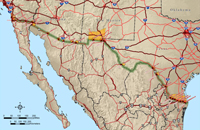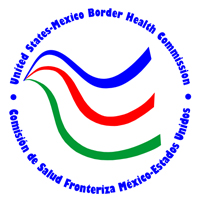Office of Border Health

The mission of the Office of Border Health (OBH) remains the same as since its inception: improvement of the health status and health services in the New Mexico/Mexico Border Region and other border-impact areas of the State. While OBH originally served a large transient population that moved in and out of the Border Region, beginning in the late 1990s, these groups of migrants—both legal residents and the undocumented—began to take part- or full-time employment and permanently settle into ethnic and culturally unique enclave communities throughout the State, in both rural and urban settings. This transition has also led to new public health challenges. The great majority of the families in these communities live far below the poverty level, do not possess health insurance, and access health care primarily as indigents.
In the early 1990s, the New Mexico Department of Health (NMDOH) had a much larger role in delivering health services, especially in maternal and child health for underserved residents in rural areas. OBH operated a mobile clinic to provide a variety of health care services to thousands of people lacking ready access to such services due to distance and/or the dearth of alternative medical service providers. Since that time, and in response to population growth and changing demographics, the NMDOH has collaborated with the Executive and Legislative branches of State Government, federal agencies and non-profit organizations, to improve health care in these areas. Since OBH was established in 1993, local public health offices operated by NMDOH, but more importantly, private non-profit community health centers and specialty health services providers have been established throughout New Mexico’s Border Region.
Table of Contents
- Publications & Resources
- Demographics
- Binational, Regional & Local Coordination
- Epidemiology & Surveillance
- Partnering Organizations
Recent Activity
Publications
Latest
- Healthy Border 2030 (Report)
- Border Health Report 2013 (Report)
- Healthy Border 2020 (Report)
Resources
Latest
- U.S. Census Bureau, County Population Totals and Components of Change: 2020-2022
- Binational Border Infectious Disease Surveillance Program
- Respiratory Syncytial Virus Infection (RSV)
Popular
Publications & Resources
Reports
Videos
- Playing with Fire
- The Zebra Among the Horses
- I Wish I Had Known
Demographics
Southern New Mexico shares 180 miles of international border with Mexico (or 9% of the total US-MX border), mostly with the Mexican state of Chihuahua. The counties contiguous with Mexico are the southern counties of Doña Ana, Luna, Grant, Otero, Sierra, and Hidalgo. Over 65% of the border population in these counties are considered of Hispanic ethnicity, a 2022 estimate.
Population Breakdown
| County | Population |
|---|---|
| Doña Ana County | 220,060 |
| Grant County | 28,205 |
| Hidalgo County | 4,164 |
| Luna County | 25,458 |
| Otero County | 67,862 |
| Sierra County | 11,562 |
| Total | 357,311 |
United States-México Border Health Commission
 The New Mexico OBH represents New Mexico Department of Health as part of the United States-México Border Health Commission (USMBHC).
The New Mexico OBH represents New Mexico Department of Health as part of the United States-México Border Health Commission (USMBHC).
Located in key sites in the ten United States and Mexico border states, the ten OBH provide leadership at the local level. A significant portion of USMBHC resources are used to support the administration and programming of the OBH. They offer technical support and opportunities for community partners to join together in addressing border health challenges.
The OBH also serve to support USMBHC Section members.
Strategic Priorities
The role of the New Mexico OBH is to align local, state, border/binational public health agencies and organizations in support of USMBHC strategic priorities:
- Chronic and Degenerative Disease
- Infectious Disease
- Maternal and Child Health
- Mental Health and Addiction
- Injury Prevention
- Access to Care
Binational Health Councils
Paso del Norte
The Paso del Norte Binational Health Council carries out support activities for health programs on both sides of the border.
Mission
To unite efforts to gather and share information, and combine resources to create a healthy environment in the Paso del Norte region.
Vision
Good health for all, without barriers and without borders.
Objectives
- To identify health problems, which are of specific interest and concern to the geographic area of the council.
- Assess its needs and programs in order to implement strategies to solve them.
- Encourage and motivate the active participation of its members to promote the actions, recommendations and resolutions of COBINA.
Columbus-Luna County-Palomas
The Columbus – Luna County – Palomas Binational Health Council (COBINA) is the community chapter that carries out support activities for health programs on both sides of the border; established according to guidelines.
Mission
Design, promote and execute strategies to positively impact and improve public health in the Columbus-Luna County-Palomas region.
Vision
We are a binational organization performing cooperative actions to solve and prevent health-related issues within our catchment border area.
Objectives
- Identify health problems, which are of specific interest and concern to the geographic area of the council.
- Analyze its needs and programs in order to implement strategies to solve them.
- Encourage and motivate the active participation of its members to promote the actions, recommendations and resolution of the association.
Community Health Workers
The use of community members to render certain basic health services to their communities in New Mexico is a concept that has existed for at least 50 years. There have been innumerable experiences throughout the world with programs ranging from large-scale national programs, to small-scale community-based initiatives.
Community health workers are known by many different names in different countries. The umbrella term “Community Health Worker” (CHW) embraces a variety of community health aides selected, trained and working in the communities from which they come.
A widely accepted definition was proposed by the World Health Organization:
“Community health workers should be members of the communities where they work, should be selected by the communities, should be answerable to the communities for their activities, should be supported by the health system but not necessarily a part of its organization, and have shorter training than professional workers.”
Paso Del Norte Red De Promotora Network
Vision
To contribute to the public welfare and individuals in the Paso del Norte region and establish communication network between the 3 states (Texas, New Mexico and Chihuahua).
Mission
The mission of the Red de Promotoras de Salud in the Region Paso del Norte collaborates with community agencies and individuals who performs health promotion to integrate, coordinate services and provide information on the Paso del Norte region.
New Mexico Community Health Worker Association
Mission
To nurture the community health worker model to collectively improve access and quality of health care for New Mexicans by advocating for and empowering its members.
Southern New Mexico Promotora Committee
Mission
To give recognition to Promotor/as or CHW as highly trained, educated, and valued partners in the health care system within the community. To be united as one voice to advocate for the best interest of promotor/as or CHW. To be committed to addressing border health issues to improve US-MX border communities.
Vision
We envision being recognized and supported from a state level and having a voice concerning the new health advocacy program being developed in New Mexico.
Epidemiology & Surveillance
Border Infectious Disease Surveillance Program

The Border Infectious Disease Surveillance (BIDS) program, through the OBH, ensures that relationships with Mexican colleagues are maintained through regular and effective communication and information exchange, collaborative surveillance activities, partnership in special projects, and offering capacity-building and training in epidemiology, surveillance and laboratory diagnostics. The BIDS surveillance officer integrates essential border and binational partners in all projects and activities as planned through the BIDS program. These activities specifically ensure partnership and collaboration with Mexican colleagues, as well as other border public health colleagues and stakeholders, is continued in order to effectively conduct infectious disease surveillance that will bring adequate and appropriate public health response when it is necessary.
Visit the Binational Border Infectious Disease Surveillance Program website to learn more.
Partnering Organizations
The New Mexico Office of Border Health liaises with various agencies and organizations at the state, national, binational and international levels with the express purpose of coordinating vertical (US state to Mexican state), horizontal (among all US border states) and Mexican states), and border-wide (the entire US-MX Border Region) alliances and border health programming.
The OBH works closely with management and staff of the New Mexico Department of Health Public Health Southwest Region. The Southwest Region serves all the State’s border region, where one or more Local Public Health Offices are found in each county. This the border region includes almost all of the geographic area of Hidalgo, Luna and Doña Ana counties, and small portions of Grant, Sierra and Otero counties. The OBH also coordinates a number of activities with Public Health Southwest Region including, but not limited to: health fairs, immunization events, emergency preparedness and response, infectious disease epidemiology and surveillance, and health literacy and promotion.
OBH has established vertical alliances with both Chihuahua and Sonora State Health Services to coordinate the implementation of a range of border health programs to improve health conditions and uphold public health objectives in their shared Binational Border Region. The Mexican States of Chihuahua and Sonora each have separate Agreements of Understanding, signed by the Governors and Health Secretaries of each state, with New Mexico, USA.
At the horizontal level, OBH has forged partnerships with the Arizona Office of Border Health, Texas Border Health Services, and California Office of Border Binational Health. Efforts with these agencies include the development of: compatible communication; reporting and case management protocols for infectious diseases including tuberculosis; regional health emergency preparedness; professional development and training; and multi-state and border-wide multimedia health promotion and education initiatives.
The US-Mexico Border Health Commission is a unique binational entity that involves membership of the US and Mexican federal health secretaries as commissioners, and member delegations from each of the six Mexican and four US state health authorities. The Commission is made up of US and Mexican Sections to facilitate implementation of Commission initiatives in each country and in binational partnerships. The full commission meets once a year at alternating locations in the US and Mexico. OBH maintains a cooperative agreement with the Office of Global Affairs to carry out selected activities as prioritized by the Commission. Most of these activities are implemented in tandem with the other US border states and especially in cooperation with New Mexico’s sister state of Chihuahua and West Texas. These activities include Border Binational Health Month.

